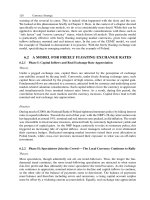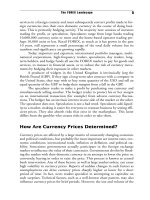A MANAGER’S GUIDE TO COACHING pdf
Bạn đang xem bản rút gọn của tài liệu. Xem và tải ngay bản đầy đủ của tài liệu tại đây (1.94 MB, 240 trang )
Praise for
A Manager’s Guide to Coaching
“This book does a great job of examining an area of leadership often over-
looked by new (and seasoned) managers. Practical, and easy to read, it lays out
a management concept that can positively impact employees and ultimately
the bottom line.”
—Stephanie Heffernan, Executive Producer,
E-Commerce, Discovery Communications, Inc.
“Practical. Insightful. Entertaining. This no-nonsense look at coaching is a
must read. Not only for those who manage others, but for anyone that hopes
to help the people they work with to be more.”
—Carole Dickert-Scherr, Vice President,
Human Resources, PBS (Public Broadcast Service)
“Brian Emerson and Anne Loehr are the leaders you need for coaching your
team to victory. Their thorough but easy to understand guide sets out the steps
you need to take to make sure you have motivated and successful employees.
The key is realizing that coaching in not about telling people how to be better,
but helping them effectively achieve their own level of awareness and action.”
—Wesley Warren, Director of Programs for Natural Resources Defense
Council, formerly Associate Director for the Office of Budget
and Management in the Clinton White House (1994-2001)
“Employee development is at the heart of every manager’s job and, as Brian
and Anne clearly demonstrate, coaching is the key to unlocking human poten-
tial. The authors help managers better understand the nature of their task by
providing both practical guidelines and relevant examples and cases that bring
their ideas to life. No matter how experienced, every manager has something
to learn about improving performance, and those who adopt the coaching
practices described in this book are certain to WIN BIG.”
—Judi Brownell, Ph.D., Professor and Dean of Students,
School of Hotel Administration, Cornell University
“Anyone who manages people needs to read this book. It’s full of practical
advice, case studies, tips and proven systems for coaching employees to success.
Our company is learning the important role that asking questions plays in
overall success. This book unlocks that secret in a real, down-to-earth way.”
—David Collins, President & CEO,
ARC (Airlines Reporting Corporation)
“Written in a breezy, easy-to-read format, this book offers managers, particu-
larly those new to coaching, insights into how to get better results from direct
reports. This book is the real deal. Seasoned beyond their years, Brian and
Anne offer counsel that is both wise and practical to individuals at all levels of
an organization.”
—David Coleman, President,
Transitional Management Services
“The manager’s guide is a sophisticated tool written in ‘plain English.’ This is
a practical approach to the complicated challenges managers face in non-prof-
it (or any) leadership [position]. Written with pervasive good humor and good-
will toward all, The Manager’s Guide to Coaching makes workplace issues seem
more interesting and less vexing.”
—Craig Shniderman,
Executive Director, Food & Friends
“The coaching methods developed by Brian are among the most effective staff
development tools in my management toolbox. The questioning techniques
help create a supportive and solution-focused framework in what might other-
wise be difficult conversations with struggling staff members. I even find the
techniques effective in self-reflection on my personal performance.”
—Charlotte Brantley, President and CEO,
Clayton Early Learning Foundation
“This book does a great job of presenting the model of coaching that has been
very beneficial for me. I have worked with Brian for several years. The hours
I’ve spent with him, being coached and learning to coach others, have been
some of the most meaningful and valuable of my career.”
—John Kyle, Vice President, Marketing, LogiXML
A MANAGER’S
GUIDE
TO COACHING
Simple and Effective Ways
to Get the Best
Out of Your Employees
Brian Emerson & Anne Loehr
American Management Association
New York • Atlanta • Brussels • Chicago • Mexico City
San Francisco • Shanghai • Tokyo • Toronto • Washington, D. C.
Special discounts on bulk quantities of AMACOM books are available to corporations, pro-
fessional associations, and other organizations. For details, contact Special Sales Department,
AMACOM, a division of American Management Association, 1601 Broadway, New York, NY
10019.
Tel.: 212-903-8316. Fax: 212-903-8083.
Web site: www. amacombooks.org
This publication is designed to provide accurate and authoritative information in regard to the
subject matter covered. It is sold with the understanding that the publisher is not engaged in
rendering legal, accounting, or other professional service. If legal advice or other expert assis-
tance is required, the services of a competent professional person should be sought.
Library of Congress Cataloging-in-Publication Data
Emerson, Brian, 1967–
A manager’s guide to coaching : simple and effective ways to get the best out of
your employees / Brian Emerson, Ann Loehr.
p. cm.
Includes index.
ISBN 978-0-8144-0982-4
1. Employees—Coaching of. 2. Employee motivation. 3. Problem solving.
I. Loehr, Ann. II. Title.
HF5549.5.C53E44 2008
658.3′124—dc22
2007045792
©2008 Brian Emerson and Anne Loehr
All rights reserved.
Printed in the United States of America.
This publication may not be reproduced, stored in a retrieval system, or transmitted in whole or
in part, in any form or by any means, electronic, mechanical, photocopying, recording, or other-
wise, without the prior written permission of AMACOM, a division of American Management
Association, 1601 Broadway, New York, NY 10019.
Printing number
10 9 8 7 6 5 4 3 2 1
Contents
acknowledgments ix
1 Getting the Best from Employees 1
The Success Equation 2
Using This Book to Coach Successfully 14
2 The What, Why, and When of Coaching 17
What Is the Tool of Coaching? 19
Coaching versus Therapy 26
When to Coach and When Not to Coach 28
To Coach or Not to Coach—Case Studies 33
3 How to Coach and W.I.N. B.I.G.! 45
The Coaching Process 46
Coaching Questions 49
The W.I.N. B.I.G. Coaching Formula 58
Coaching Frequently Asked Questions 79
4 The Tenets of Coaching 85
Coaching Mindset 88
Coaching Actions 88
v
vi Contents
Coaching Tricks of the Trade 89
The Seven Tenets of Coaching Mindset 90
The Seven Tenets of Coaching Actions 102
The Seven Tenets of Coaching Tricks of the Trade 111
5 How Do I Use This Book? 125
Using This Book as a Resource to Coach Employees
and Colleagues 127
Using the Book as a Tool to Give to Employees to Kick-Off
and/or Support Coaching 133
Using This Book as a Tool to Coach Yourself 135
6 W.I.N. B.I.G. Questions for Specific Coaching
Situations 141
Interpersonal Problems 149
Motivation 153
Time Management 158
Dealing with Conflict 162
Clarifying Goals 167
(Lack of) Available Resources 171
Developmental Opportunities 175
Life Balance 180
Conflicting Priorities 184
Delegation 189
Increasing Confidence 193
7 W.I.N. B.I.G. Questions for Any Coaching Situation 199
Wonder about Root Cause—Discovery 200
Investigate Wants—Vision 203
Name Possible Solutions—Problem Solving 207
Build a Plan—Action 210
Contents vii
Insure Action—Accountability 214
Give Affirmation—Validate 218
Index 223
About the Authors 229
This page intentionally left blank
Acknowledgments
To be a coach requires one to have a desire to see another
succeed. In that respect, we have had many coaches in our lives to
whom we are greatly indebted. Some have been supportive, some have
helped us learn, and some have helped us time and time again to over-
come the hurdle that is ourselves. To all of them, we say thank you for
the role you played in not only shaping this book, but in shaping us
as well. To name them all would be an impossible feat, but there are
some who deserve special mention in conjunction with this project.
Thank you to our clients (individuals and organizations) with
whom we learn and in whom we believe.
Thank you to our colleagues and partners in learning—
especially David Coleman, Amy Levine, Chuck Miller, Leah Rampy,
Lisa Silverberg, and Jerren Pellicano for their input, review, and assis-
tance in completing this work.
Thank you to Grace Freedson and Christina Parisi our agent
and editor, respectively, who guided us through this new and excit-
ing experience.
Thank you to our parents, siblings, nieces, and nephews who
have coached and loved us unceasingly throughout the years.
Finally, thank you to Ariana, Neel, and Stephen for their
unending support of this project and of us as people. We hope you
know that we believe in you just as much as you believe in us.
ix
This page intentionally left blank
Getting the Best
from Employees
1
If you’re not growing, you’re dying.
It’s a basic rule of life here on earth and in the business world
today. It’s what drives most of us to be better at what we do and who
we are. It’s the desire to “be more.” Because of this desire, the term
“coaching” has caught the attention of both the personal-growth
and business worlds, creating a multibillion-dollar-a-year industry
and a situation in which everyone wants a coach. More than ever,
employees are asking for developmental opportunities and managers
are being told they need to “coach” their employees on a regular
basis. We’ve even worked with managers who say they’ve been told
to “stop managing and start coaching.” This all sounds great in the-
ory—managers coaching employees to grow and be more effec-
tive—but there’s one problem. Although many people agree that
having a coach is a great way to move toward success, very few peo-
ple know what a coach actually is or what a coach actually does. This
leaves many managers scratching their heads as they try to fit one
more ambiguous task into their already over-busy schedules.
So what is a coach, and what is coaching? This is our defini-
1
2 A Manager’s Guide to Coaching
tion: A coach is someone who helps another person reach higher
effectiveness by creating a dialogue that leads to awareness and
action. By creating the space to step back, look in the mirror, and
grapple with the tough questions, a coach helps a person examine
and deal with their reactions to obstacles and, in a sense, “get out of
their own way” as they achieve better results, in a more efficient
manner.
But why is this important? Why is helping a person deal with
their own personal obstacles so necessary? Why can’t people just
focus on the task at hand and put all that other emotional stuff
to the side? The answer, much to the chagrin of many people and
managers, is that as humans, we don’t have a choice. If we are going
to grow, be more, and reach higher levels of effectiveness, we have
to spend time learning how to clear one of the biggest hurdles of
success—our own emotional baggage.
THE SUCCESS EQUATION
When we are faced with a task (in business, or any aspect of life),
there are three things that we need to be as successful as possible:
• Aptitude—the know-how, skills, and capacity to complete the
task at hand
• Attitude—the drive, confidence, focus, and determination to
complete the task at hand
• Available Resources—the tools, equipment, and time needed to
complete the task at hand
Without these three components, we cannot be at the top of
our game. The degree to which each of them does or does not exist
directly contributes or detracts from our ultimate level of success. It
can be thought of as an equation with variable components.
Getting the Best from Employees 3
Start with Aptitude, the most obvious component of the equa-
tion. Without the proper skills and know-how (Aptitude) to com-
plete a task, we are left scratching our head and frustrated. Think of
a kid on her birthday receiving
her first shiny, new bike. She has
the determination and excite-
ment (Attitude) to ride her new
wheels (Available Resources), but
she lacks the skill and ability
(Aptitude) to go whizzing down
the street as she envisions. After
two or three wipeouts, you end
up with a frustrated little birth-
day girl.
Just as crucial to the equa-
tion is having the Available
Resources to complete the task. Think of the last time your team at
work had a great idea or new approach to accomplishing success—
but you lacked the budget, time, or people power to execute it. You
had the capacity to figure out a new solution (Aptitude), the drive
and confidence to make it a reality (Attitude), but lacked the money
or people (Available Resources) to pull it off. Not a fun place to be
in, by any stretch of the imagination.
The terms Aptitude and
Attitude are not perfect
descriptors and mean more
here than in their traditional
definitions. Aptitude is
about more than someone’s
innate talent, and talking
about someone’s Attitude is
about more than someone’s
positive or negative attitude.
Aptitude + Attitude + Available = Level of
Resources Success
• Know-How • Drive • Tools Low Medium High
• Skills • Confidence • Equipment
• Ability • Focus • Time
• Enthusiasm
4 A Manager’s Guide to Coaching
As managers, and people, we are comfortable and see the need
to focus on Aptitude and Available Resources. When things aren’t
working in the office, managers are often very willing to train peo-
ple in new skills or throw more money at the problem. However, it’s
the middle part of the Success Equation—the keystone if you will—
that most people tend to overlook, forget about, or outright ignore.
Attitude refers to things like the drive, confidence, focus, chutzpah,
enthusiasm, grit, determination, need, desire, fortitude, and inspira-
tion to accomplish the task at hand. Although difficult to measure
and manage, without the right Attitude, having only the Aptitude
and Available Resources will get you nowhere. Unfortunately, man-
agers often say things like, “why can’t people just do their jobs and
leave all that other stuff at home.” Well, people don’t “leave all that
other stuff at home” because as humans, we can’t. Understandably,
many managers wish that this was not the case, because managing
would be immensely easier if people could really “check their emo-
tions at the door.” We get it, and, unfortunately, it’s not possible.
Think of the times your work day has been affected because you
were ill, or you had a fight with a family member. This doesn’t even
include the events that happen at work. When rumors of a down-
sizing start in an organization, how many people are able to com-
pletely check their emotional reaction to the news and focus 100%
on their work? Not many. So, for better or worse, managers have to
accept that our Attitude affects our Level of Success, and focusing
on it is more than “a nice thing to do.” Like it or not, Attitude is
hardwired into the Success Equation for humans, and not just as a
variable on the periphery. Attitude is perhaps the most vital compo-
nent in the entire equation, and focusing on it is a manager’s busi-
ness imperative.
Hardline business people are often most comfortable thinking
of this in terms of sporting analogies. Anyone who has played sports
has probably been told at one time or another to “get your head in
the game,” “focus,” “get psyched up,” or “don’t think that you can’t
Getting the Best from Employees 5
beat these guys!” Sports coaches know that the confidence, drive,
and determination (the Attitude) of their athletes can make all the
difference between playing and winning.
When a consistent athlete has a “bad day,” we say they were
“off their game” or that they “completely psyched themselves out.”
But what’s changed in the Success Equation? They have the same
skills and ability that they had when they won the game last week.
Assuming that they are healthy, rested, physically fit, and that their
equipment is in working order, then the variable in the equation has
to be the athlete’s Attitude—their focus, confidence, determination,
or desire.
Champions aren’t made in the gyms. Champions are made
from something they have deep inside them—a desire, a
dream, a vision.
—Muhammad Ali, American Boxer
/>Aptitude + Attitude + Available = Level of
Resources Success
• Know-How • Drive • Tools Low Medium High
• Skills • Confidence • Equipment
• Ability • Focus • Time
• Enthusiasm
As Attitude shifts and drops, the result is a shift in the level of
success—and this decrease can be the difference between winning
and losing.
6 A Manager’s Guide to Coaching
Good sports coaches know that the key to working with top
athletes is focusing on the Attitude piece of the success equation—
not because “focusing on this stuff makes people feel good and is a
nice thing to do,” but because the Level of Success depends on it.
Attitude is the keystone in the success equation that can affect the
Level of Success in exponential ways. Let’s examine three of the rea-
sons why this is true and how managers get in trouble by ignoring
the Attitude component of the equation.
• Improved Attitude can compensate for deficiencies in Aptitude
or Resources.
• A decrease in Aptitude or Resources often negatively affects
Attitude, which can further hinder the Level of Success.
• The converse of the above is not true—A negative Attitude does
not decrease the level of Aptitude or Resources.
Let’s take a look at each of these individually.
Improved Attitude can compensate for deficiencies in Aptitude or
Resources.
The first point above is what leads some to say that Attitude is
the make-or-break factor of the success equation. Think of the mul-
tiple stories of athletes who have suffered an injury but upped their
determination and grit to produce highly successful results. Kerri
Strug, the gymnast in the 1996 Olympic Games who completed
(and nailed) her final vault with two torn ligaments in her ankle is
a perfect example—and there are thousands of others. This rule
holds true outside of the sports world as well—it’s evident in all
aspects of our life and the business world. When faced with a lack
of Aptitude or Resources, people will often “dig deep” to find the
extra determination they need to win in a big way. Viewed in this
manner, it is unarguable that Attitude is a central, and powerful,
part of the success equation.
Getting the Best from Employees 7
A decrease in Aptitude or Resources often negatively affects Attitude,
which can further hinder the Level of Success.
Attitude is the only piece of the success equation that is direct-
ly affected by a shift in the other two components. Suppose John is
leading a successful project at work.
He has a high level of Aptitude and Attitude and is utilizing the
Available Resources that he needs to reach a high level of success.
Then, as is often the case, something changes. Assume that John
loses two people on his team and finds out that the project deadline
has been moved up a month earlier because of client demands.
Obviously, fewer people and less time affect the Available Resources
part of the equation, which in turn lowers the Level of Success.
Aptitude + Attitude + Available = Level of
Resources Success
• Know-How • Drive • People
Low Medium High
• Skills • Confidence • Equipment
• Ability • Focus • Time
• Enthusiasm
Aptitude + Attitude + Available = Level of
Resources Success
• Leadership • Drive • Less People Low Medium High
• Skills • Confidence • Equipment
• Ability • Focus • Less Time
• Enthusiasm
8 A Manager’s Guide to Coaching
What is interesting about the Attitude component of the equa-
tion is the degree to which it is affected by a shift in the other com-
ponents. As the project continues with increasing time pressure and
fewer people power, it is understandable that John could become
more frustrated and less confident in the success of the project. At
the very least, he has more to do with less bandwidth which results
in less focus. This shift in Attitude could further hinder the overall
success of the project.
Aptitude + Attitude + Available = Level of
Resources Success
• Leadership • Drive • Tools Low Medium High
• Skills • Unconfident • Equipment
• Ability • Less Focus • Time
• Frustrated
Shifting Available Resources can directly affect Attitude. The
same holds true with Aptitude. Think back to the example of the
birthday girl and her new bike. She lacks the skills and know-how
to ride the bike, and as a result, she is frustrated and unconfident.
Now, before she can really learn the skills she needs to ride the bike,
she has to overcome her frustration and be confident enough to try
again. The same holds true for adults in the workplace. When an
employee lacks the skills and ability to complete a certain aspect of
a task, chances are their confidence and level of frustration will also
be affected in the process. Thus, the ultimate Level of Success is
affected in an exponential manner.
Getting the Best from Employees 9
The converse of the above is not true—A negative Attitude does
not decrease the level of Aptitude or Resources.
The third point outlined above is as vital as the first two.
Assume Ariana is a highly skilled and focused employee who expe-
riences high levels of success in her job.
Aptitude + Attitude + Available = Level of
Resources Success
• Talented • Driven • Tools
Low Medium High
• Skilled • Confident • Equipment
• Smart • Motivated • Time
• Focused
Aptitude + Attitude + Available = Level of
Resources Success
• Talented • Not Driven • Tools Low Medium High
• Skilled • Unconfident • Equipment
• Smart • Unmotivated • Time
• Unfocused
One day, rumors begin to swirl that a downsizing is going to take
place in the next 9–12 months and Ariana hears through the grape-
vine that her position will be eliminated. These rumors obviously
change the success equation—but in only one area—Attitude.
Ariana’s drive, confidence, and focus may be negatively affected by
the situation, which may decrease her level of success.
10 A Manager’s Guide to Coaching
However, unlike the previous example of John, this impact or
shift in the Attitude component of the equation does not, in any
way, affect the other components of the equation. Ariana’s dip in
Attitude does not lower or change her Aptitude or her Available
Resources. Additionally, unlike the athlete who can compensate for a
lower part of the equation by upping his Attitude, as long as Ariana’s
Attitude is negatively affected, there is nothing that additional
Aptitude or Available Resources can do to raise her Level of Success.
Again, Attitude is the keystone in the success equation.
All of these factors combined make learning how to improve
someone’s Attitude an extremely important skill. Managers need to
be aware of, work to manage,
and learn to develop the Atti-
tude (the determination, moti-
vation, focus, drive, confidence)
of their employees.
We work with many man-
agers who respond at this point
by saying something like, “Yeah,
but why do I need to take the
time to worry about coaching
my employees? I have enough
on my plate already, and this coaching fad is a time-intensive process
that doesn’t directly contribute to the bottom line.”
If you think you don’t need to be coaching as a manager, think
again. As a manager, one of the most important business imperatives
you have is managing and developing the talent of your organiza-
tion. If you don’t, chances are that talent will go elsewhere, which
costs your organization a lot of money. The cost to replace an
employee is higher than you might think—up to 1.5–2 times their
annual salary. Think about it, the money adds up—the lost produc-
tivity as the person is leaving and while the position is vacant, the
An employee having a
“high” Attitude can affect
their Level of Success in a
very positive way. As a
manager, look for the good
parts of people’s Attitude
and find ways to help them
capitalize on it.
Getting the Best from Employees 11
time and money associated with recruiting, interviewing, and other
human resources functions, and finally, the cost of lost productivi-
ty as a new person is trained and gets up to speed. All of this plus
there is quite a good chance that the new employee will not even
work out!
Poor management results in huge costs to an organization. A
disturbing truth for managers is that most of the time, when people
quit their jobs, they are not leaving an organization; they are leaving
their manager. Research has shown that the most common reason
employees leave a company has to do with their relationship with
their immediate supervisor.
1
As much as organizations don’t like to
admit it, people leave as a direct result of something that their man-
ager is, or is not, doing.
Another reason people leave their job is lack of developmental
opportunities. People want to be developed. Gen X-ers (born after
1965) and Gen Y-ers (born between 1981 and 1995) consistently
cite “the opportunity to develop” as one of the key indicators of job
satisfaction, and they consistently turn to their managers for that
opportunity. Charlotte Shelton and Laura Shelton, authors of The
NeXt Revolution, asked 1,200 Gen-X employees to rank, in order of
importance, their most important job characteristics. The top three
characteristics were positive relationships with colleagues, interest-
ing work, and continuous opportunities for learning.
2
They want to
be exposed to new things that push their boundaries and make them
more employable in the future. For this to happen, and for these
employees to reach high Levels of Success, managers must be tuned
1
CareerBuilder.com, “How to Cope with a Problem Boss,” />2006/US/Careers/07/26/cb.hate.boss/index.html (accessed July 26, 2006). © Copy-
right CareerBuilder.com 2005. All rights reserved.
2
Fisher, Anne, “What Do Gen Xers Want?” Fortune (January 20, 2006). http://money
.cnn.com/2006/01/17/news/companies/bestcos_genx/index.htm.
12 A Manager’s Guide to Coaching
in to not only increasing the Aptitude of these employees, but they
must also be keenly aware of and help develop the Attitudes of these
employees as well. If employees are really going to develop and excel,
their managers must help enhance their confidence, motivation,
determination, energy, and focus as they learn increasingly complex
skills.
When broken down, it’s hard to refute the fact that taking
the time to manage and develop the talent of one’s employees is a
critical business imperative for managers of all levels. To do so, one
must focus on the entire Success Equation—Aptitude, Attitude, and
Available Resources. Because Attitude is the keystone of success, to
effectively develop their employees, managers have to coach. Think
of it this way:
• Employees want to be developed and look to their manager for
that development.
• If they don’t get it, they will leave that manager and be hired else-
where.
• Each time this happens, poor managers cost the organization
hundreds of thousands of dollars, which most organizations don’t
have to throw away.
• Therefore, managers have a business directive to develop their
employee talent within an organization.
• Developing employees cannot happen unless a manager focuses
on increasing the employees’ Aptitude and Attitude.
• The Attitude component of the Success Equation is best devel-
oped through coaching.
Because of this, we believe the question is not, “Why should I
waste my time and resources by focusing on coaching?” The real
question is, “How can I not waste my time and resources?” The
answer: “By focusing on coaching.”
Getting the Best from Employees 13
If you still think that Attitude doesn’t play that big of a role in
people’s day-to-day work life, think through these examples.
• You have the skills to do the job, but due to the recent down-
sizing you have almost double the work to accomplish. Due to
the positive relationship you have with your boss, you are very
committed to the job. You are determined to excel and motivat-
ed to make your group look good. Will you be successful?
Probably. More than likely, your higher Attitude is affecting your
Level of Success despite the lack of Available Resources. Even if
you are not 100% successful due to the downsizing, you will
have a higher level of success
than someone in the same sit-
uation who is not motivated,
unfocused, and uncommitted
to the job.
• Your team lands a huge,
highly-competitive account
that brings a new level of pres-
tige to your firm. The new
client loves all of your pro-
posed ideas and tells you to
think even bigger as you move
forward. Everyone is extremely excited and motivated to get start-
ed even though you are down one team member due to an extend-
ed leave of absence. Is the pump primed for a successful project?
Yes. Your team has the Aptitude, and a high Attitude as a result of
the new client, which will more than compensate for the lack of
Available Resources (due to the leave of absence),
So what does all of this have to do with coaching? In short,
coaching helps people raise the Attitude component of the Success
In addition to developing
employees, coaching also
increases productivity, satis-
faction, and the amount of
institutional knowledge
retained as a direct benefit
of the good management
that results from supervisors
learning to coach.
14 A Manager’s Guide to Coaching
Equation. Again, our definition of coaching is helping another per-
son reach higher effectiveness by creating a dialogue that leads to
awareness and action. By creating the space to step back, look in the
mirror, and grapple with the tough questions, coaching helps a per-
son effectively deal with their reactions to the hurdles that are in
their way as they move forward to achieve better results, in a more
efficient manner.
USING THIS BOOK TO COACH SUCCESSFULLY
Effectively managing and developing the Attitude component of self
and others is a vital skill for managers who want to be more suc-
cessful, and coaching is the best way of doing that. Most average
managers are capable of increasing an employee’s Aptitude and find-
ing Resources for their ultimate success. The difference between an
average manager of people and a star manager lies in the one’s abil-
ity to move people to higher levels of success when something is
affecting their Attitude (drive, confidence, focus, determination,
and/or energy). This is where the skill of coaching comes in.
Coaching focuses on the Attitude part of the Success Equation.
It helps employees clarify what they really want to achieve and how
to achieve it. After raising this awareness, coaching moves employ-
ees to action as the coach helps inspire them to strategize, plan, and
hold true to their commitments.
There is incredible power in working with a coach, both in
business and in real life. We have seen the shifts that occur in peo-
ple’s lives as a result of coaching. We have seen people achieve
incredible things and get what they really want. We have seen, and
experienced for ourselves, the ways in which coaching helps people
“be more”—more successful, more productive, more fulfilled, and
finally, more alive.









